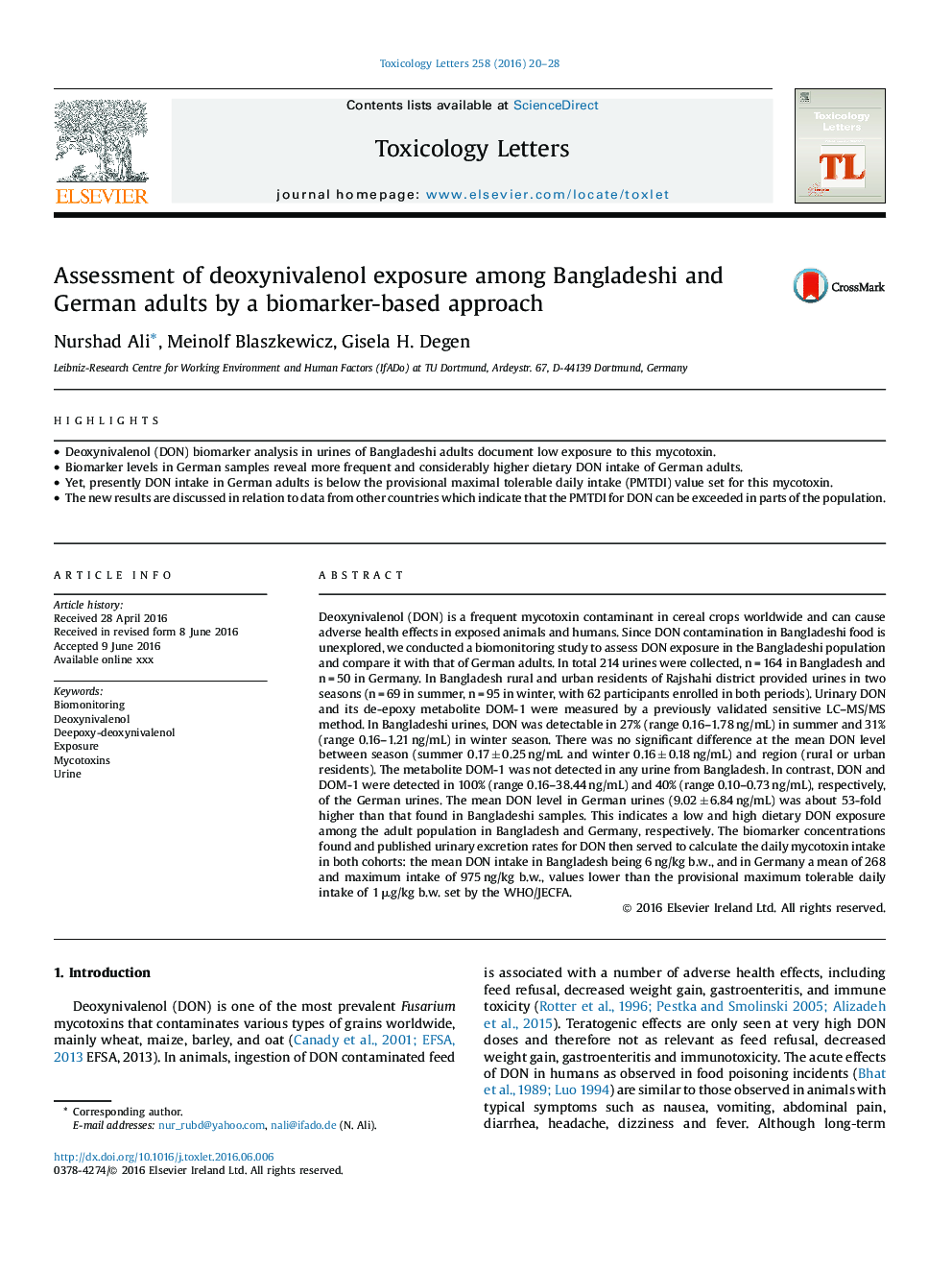| کد مقاله | کد نشریه | سال انتشار | مقاله انگلیسی | نسخه تمام متن |
|---|---|---|---|---|
| 5859718 | 1562615 | 2016 | 9 صفحه PDF | دانلود رایگان |
عنوان انگلیسی مقاله ISI
Assessment of deoxynivalenol exposure among Bangladeshi and German adults by a biomarker-based approach
ترجمه فارسی عنوان
ارزیابی قرار گرفتن در معرض دونوکسینوالنول در بین بزرگسالان بنگلادش و آلمان با استفاده از رویکرد مبتنی بر زیست شناسی
دانلود مقاله + سفارش ترجمه
دانلود مقاله ISI انگلیسی
رایگان برای ایرانیان
کلمات کلیدی
موضوعات مرتبط
علوم زیستی و بیوفناوری
علوم محیط زیست
بهداشت، سم شناسی و جهش زایی
چکیده انگلیسی
Deoxynivalenol (DON) is a frequent mycotoxin contaminant in cereal crops worldwide and can cause adverse health effects in exposed animals and humans. Since DON contamination in Bangladeshi food is unexplored, we conducted a biomonitoring study to assess DON exposure in the Bangladeshi population and compare it with that of German adults. In total 214 urines were collected, n = 164 in Bangladesh and n = 50 in Germany. In Bangladesh rural and urban residents of Rajshahi district provided urines in two seasons (n = 69 in summer, n = 95 in winter, with 62 participants enrolled in both periods). Urinary DON and its de-epoxy metabolite DOM-1 were measured by a previously validated sensitive LC-MS/MS method. In Bangladeshi urines, DON was detectable in 27% (range 0.16-1.78 ng/mL) in summer and 31% (range 0.16-1.21 ng/mL) in winter season. There was no significant difference at the mean DON level between season (summer 0.17 ± 0.25 ng/mL and winter 0.16 ± 0.18 ng/mL) and region (rural or urban residents). The metabolite DOM-1 was not detected in any urine from Bangladesh. In contrast, DON and DOM-1 were detected in 100% (range 0.16-38.44 ng/mL) and 40% (range 0.10-0.73 ng/mL), respectively, of the German urines. The mean DON level in German urines (9.02 ± 6.84 ng/mL) was about 53-fold higher than that found in Bangladeshi samples. This indicates a low and high dietary DON exposure among the adult population in Bangladesh and Germany, respectively. The biomarker concentrations found and published urinary excretion rates for DON then served to calculate the daily mycotoxin intake in both cohorts: the mean DON intake in Bangladesh being 6 ng/kg b.w., and in Germany a mean of 268 and maximum intake of 975 ng/kg b.w., values lower than the provisional maximum tolerable daily intake of 1 μg/kg b.w. set by the WHO/JECFA.
ناشر
Database: Elsevier - ScienceDirect (ساینس دایرکت)
Journal: Toxicology Letters - Volume 258, 6 September 2016, Pages 20-28
Journal: Toxicology Letters - Volume 258, 6 September 2016, Pages 20-28
نویسندگان
Nurshad Ali, Meinolf Blaszkewicz, Gisela H. Degen,
